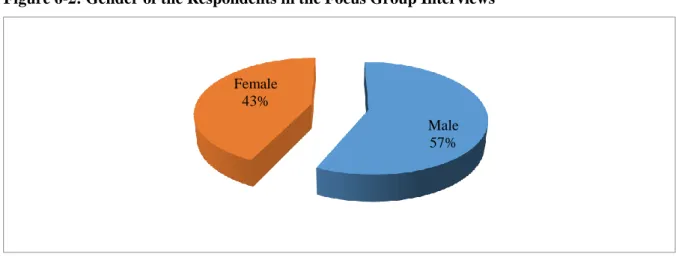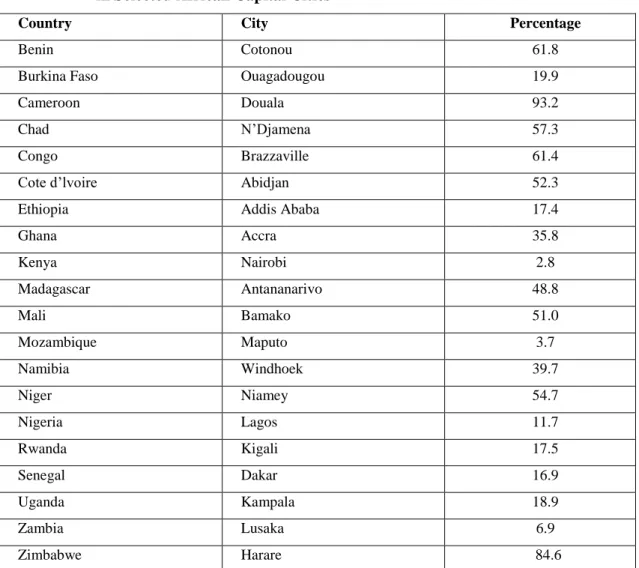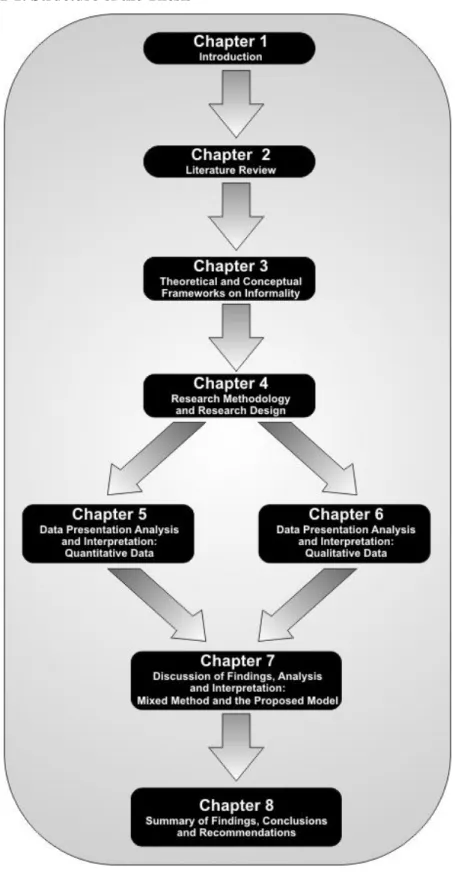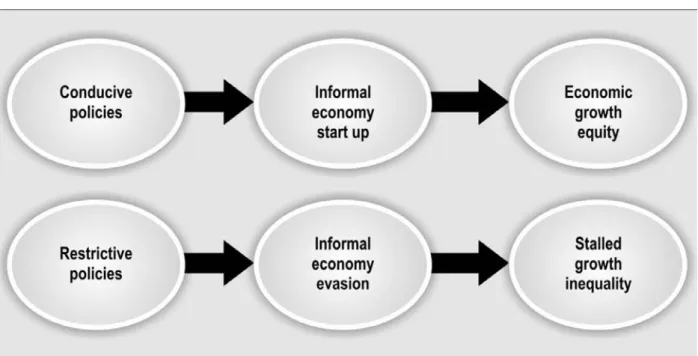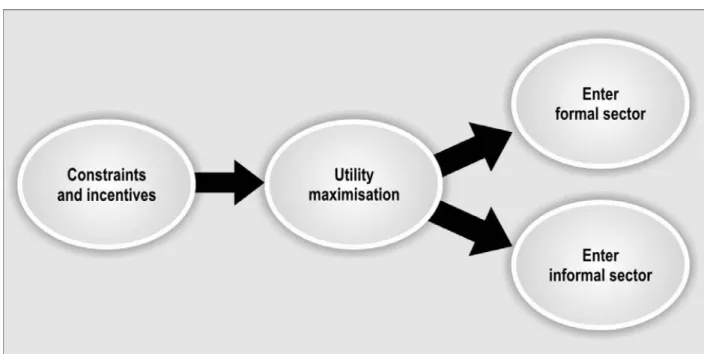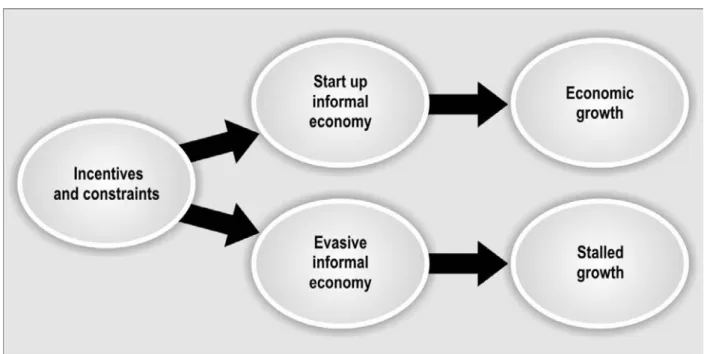Qualitative research used purposive random sampling to ensure there was fair representation of all informal manufacturing SMEs in this study. The results showed that there are more male entrepreneurs (56.15%) than female (48.85%) involved in the informal manufacturing SME sector in Zimbabwe.
INTERPRETATION: MIXED-METHOD AND THE PROPOSED MODEL
Zimbabwe theme – Proposed solutions to address these difficulties Theme – Contribution of informal manufacturing SMEs to employment Theme – Number of employees employed by the informal manufacturing SMEs per focus group Interview theme – The role of government in helping the informal manufacturing SMEs to become SMEs. Theme – Government initiatives to stimulate the development and creation of
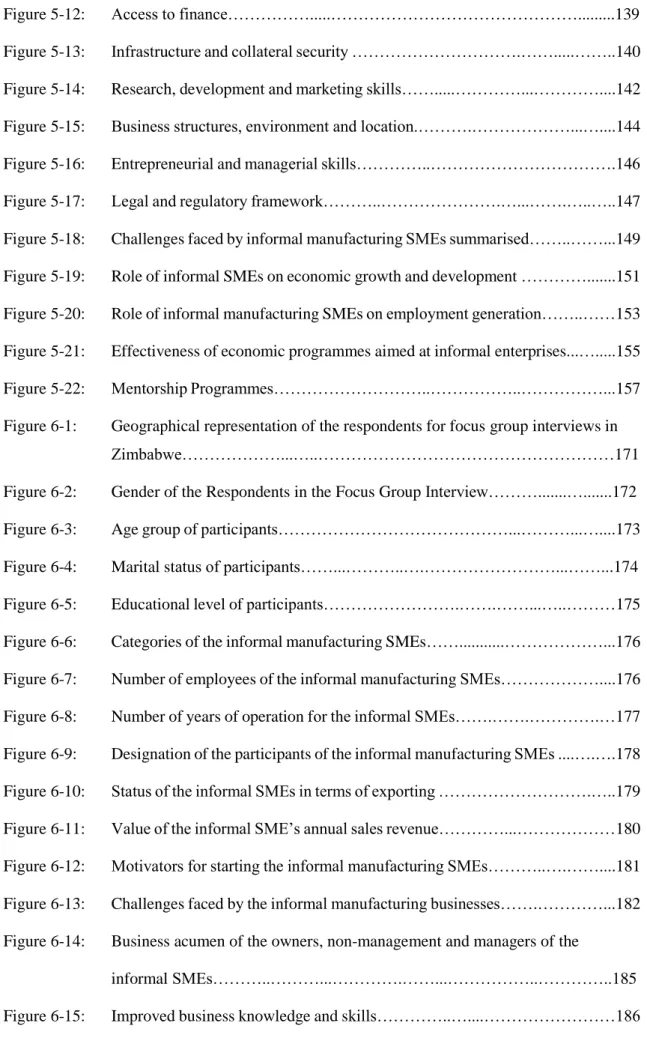
INTRODUCTION
Introduction
The African continent needs to build research output towards strong capabilities to generate quality information about the important role and contribution of the informal economies of its countries. This chapter presents a preamble to the background of the study, the background of informal SMEs in Africa, with specific reference to informal SME developments in Zimbabwe, and more specifically, informal SMEs in the manufacturing sector in Zimbabwe.
Background to the Study
- Informal SMEs: Background in Africa .1 Overview of Informal SMEs in Africa .1 Overview of Informal SMEs in Africa
- Growth with Equity Policy in Zimbabwe (GWE): 1980 to 1990
- Economic Reforms Policy in Zimbabwe: ESAP – 1991 to 2000
- Millennium Economic Recovery Programmes (MERP) in Zimbabwe: Year 2000 Zimbabwe: Year 2000
- Macroeconomic Policies Leading to Economic Collapse in Zimbabwe: 2002 to 2009 Zimbabwe: 2002 to 2009
- Reconstruction Process and Policies in Zimbabwe: 2010 to 2016
The contribution of informal sector income to total household income is significant in many regions around the globe. These programs instead of supporting the development and growth of the informal sector were in fact mandatory restrictions.

Informal SMEs in the Manufacturing Sector in Zimbabwe
- Types of Informal Manufacturing SMEs in Zimbabwe
The government of Zimbabwe, however, has partially acknowledged the importance of the informal sector by establishing the Ministry of Small and Medium Enterprises in 2005. Some scholars have argued that the informal sector has the potential to achieve high levels of productivity.
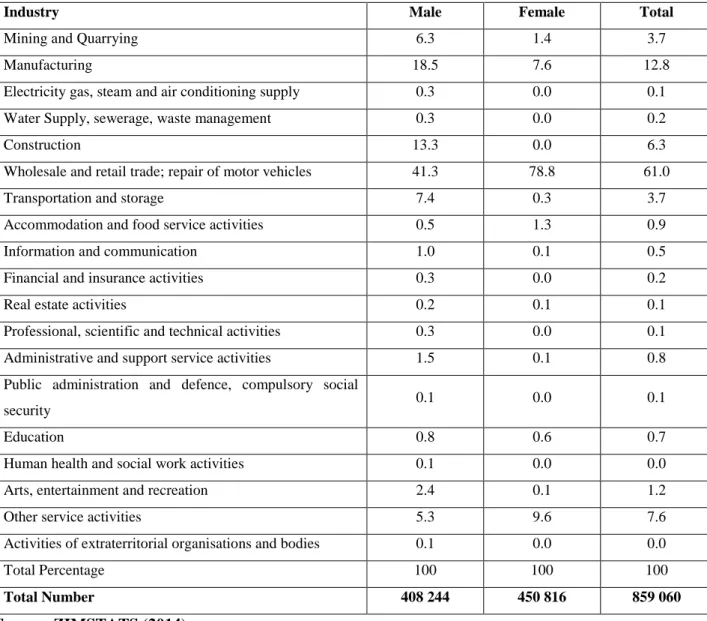
Statement of the Problem
This is despite the fact that the government of Zimbabwe adopted policies such as ESAP, ZIMPREST AND MERP which continued to stifle and stifle the growth of the informal sector after independence in 1980. The informal SMEs can therefore be used as a strategy to drive economic growth. and development in the country.
Aim of the Study
- Research Questions
- Significance of the Study
- Scope of the Study
Chen (2012) argues that the informal economy is crucial for sustainable economic growth and poverty reduction. The study is timely and significant given the slow growth rate of informal manufacturing SMEs converting to formal SMEs and the many challenges facing the informal sector in Zimbabwe (Buguit, 2015).
Delimitation of the Study
- Assumptions
- Limitations
SMEs that add to the global economy operate below their maximum capacity, face serious challenges and also remain outside the protection and regulation of governments, and Africa is no exception.
Structure of the Thesis
Summary of Chapter
LITERATURE REVIEW
Introduction
Further, the rationale of the study, the statement of the problem, the objectives of the study, the importance of the study, the purpose of the study, ethical considerations and the structure of the thesis were discussed. This chapter discusses the literature on historical perspectives of the informal sector; defining the informal sector, descriptions of informal sectors, SMEs and the operating environment, challenges faced by informal manufacturing SMEs and the links between informal enterprises and formal firms.
Historical Perspectives of the Informal Sector
In the 1990s, the globalization of economies was one of the main factors contributing to the informality of the workforce in many industries and countries (Standing, 1999). The proliferation of informal SMEs is a welcome development, as SMEs contribute significantly to economic prosperity, job creation and social stability at the global level (Ladzani and Van Vuuren, 2002).
Informal Sector Defined
The International Labor Organization (ILO) (1972) highlighted the characteristics of the informal economy as family businesses, small-micro-scale enterprises, which have no barriers to entry, and the use of labour-intensive technology. Kirshner (2009) further adds that the informal sector is also characterized by low production activities and non-compliance with the standard formal norms, economic activities and businesses outside the normal system of formal wage labour.
Informal SME Definitions
The literature (ILO, 1972; Sethuraman, 1981 and Mupedziswa, 1991) confirms that there is widespread acceptance of the characteristics discussed above as defining the fundamental status of the informal sector of SMEs. However, accounts are greatly underestimated or not measured at all due to informal enterprises that are not officially known.
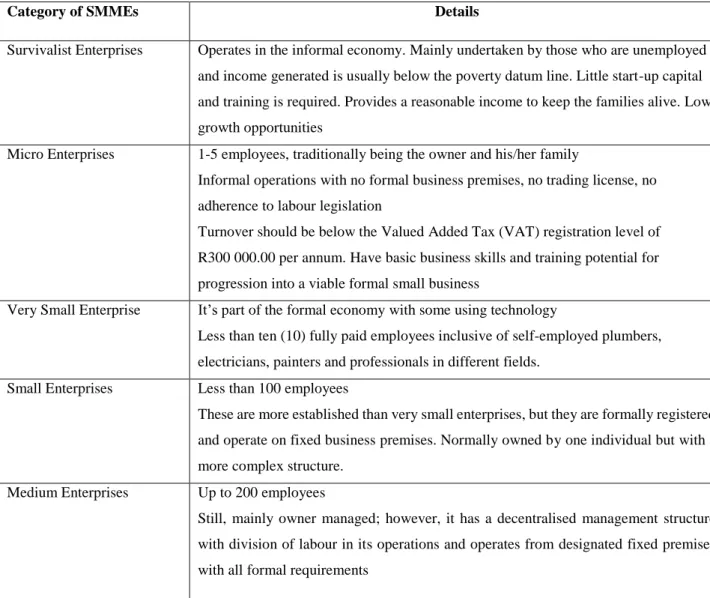
Defining an SME in Zimbabwe
- Working or ‘official’ definition: SME
- Spatial Location
- Supported-Engaged
- Value Addition
- Services Offered
- Operators’ Composition
- Returns Realised
Many who operate in the informal sector see added value as a specialty of elite operators. In most cases, they source their products for resale in neighboring countries such as Zambia, Mozambique, South Africa, Tanzania, the Democratic Republic of the Congo (DRC) and Botswana.
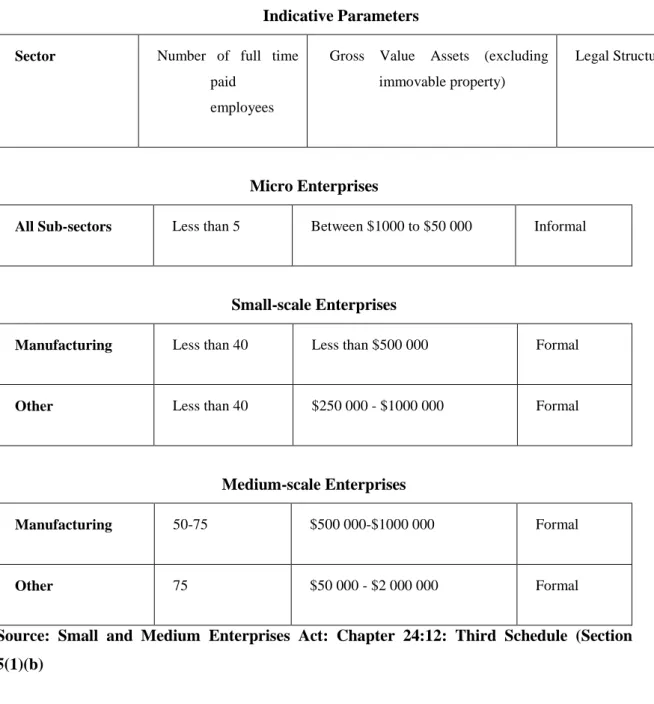
The Role of the SMEs’ and the Operating Environment
In most cases, sole traders have jobs elsewhere – sectoral or spatial – as evidenced by their absence mostly from the location of the operations. According to Djankov et al., (2002), in the African countries, high entry or regulation fees prevent the informal SMEs from becoming formal, but in Zimbabwe, Nyoni said that bad publicity of the country has a negative impact on SME growth and -development has.
Challenges Faced by the SMEs
- Accessibility to Finance / Credit
- Lack of Management and Entrepreneurial Skills
- Poor Location and Networking
- Technological Capabilities
- Government Policy towards SMEs
Hellriegel et al. (2008) point out that managerial competence is very important for the survival and growth of informal SMEs in many countries. Chen (2012) argues that the legal environment often overlooks the broad classes of the informal sector.
Linkages of Informal Enterprises with Formal Firms
- Individual Transactions
- Sub-sectors
- Value Chains
- Empirical Studies
- Informal Manufacturing Sector in India
In India, the informal manufacturing sector is one of the largest contributors to the economy. Mukherjee recommends that separate sets of well-designed policies be adopted to be delivered for the various categories of the informal manufacturing sector.
Summary of Chapter
The study by Malepe (2014) is in line with the proposed specifications of the 2030 National Development Plan as set out in NPC (2011) that increased government support to SMEs will generate more employment in South Africa. More financial and non-financial support and services must be provided to SMEs in South Africa.
THEORETICAL AND CONCEPTUAL FRAMEWORKS IN INFORMALITY
- Introduction
- Theoretical Framework on Informality
- The Dualist Theory
- Structuralist Theory
- The Legalist Theory
- The Rational Choice Theory
- The Rationalist Legalist Theory
- Theoretical Perspectives: Emergence of SMEs in Developing Countries Countries
- The Recession Push Theory
- The Labour Supply Theory
- The Liberalisation
- Theoretical Models Linked to Africa and Zimbabwe
- Informal Sector Urban Planning in Zimbabwe
- Conceptual Framework
- Informality as a Driver of Economic Growth and Development
- SMEs’ Role in Employment Generation and Industrial Development in Africa Development in Africa
- Theoretical Perspectives for Variations in the Level of Employment in the Informal Sector Employment in the Informal Sector
- Summary: Evaluations of the Three Perspectives
- Guide to Unlocking Informal SMEs’ Potential and Survival
- The Way Forward: The Formalisation Debate
- Summary of Chapter
In 1992, the informal sector was identified by the government as one of the pillars of potential employment in the country (Becker, 2004). They are (1) access to finance and/or credit (2) lack of managerial and entrepreneurial skills (3) poor location and networks (4) ill-defined legal and regulatory frameworks (5) technological opportunities (6) government policies towards the informal SMEs.

RESEARCH METHODOLOGY AND RESEARCH DESIGN
Introduction
The previous chapter discussed the theoretical and conceptual frameworks of informality in research. These theoretical and conceptual frameworks not only influenced the understanding of informality as part of the research, but also guided how this would be carried out.
Research Philosophy
This chapter presents the research philosophy, research design, mixed-methods research design process, justification for choosing the mixed-methods, mixed-methods research design, historical use of the convergent research design, flowchart of the basic procedures used in implementing a convergent parallel design, research design implementation, reliability and validity, generalizability, research protocol and ethical considerations. This study was designed within a tradition of mixed-methods research by rejecting the main claims of the incompatibility thesis which concluded that different data types and their methods of analysis are not compatible with each other and therefore should not be used together in the same study cannot be (However, 1988).
Research Design
- Justification for Choosing the Mixed-method
- Research Sites in Zimbabwe
- Harare
- Bulawayo
- Gweru
- Masvingo
- Target Population for both Survey and Focus Group Interviews
- Survey
- Focus Group Interviews
- Historical Usage of the Convergent Research Design
- Convergent Design Variants
The research sites for this study consisted of the five (5) largest cities in Zimbabwe by gross domestic product (GDP) for both the survey and focus group interviews. The rationale was that the researcher used both quantitative and qualitative data to examine the challenges faced by informal manufacturing SMEs, and the two sets of independent results were then synthesized and/or compared during interpretation.
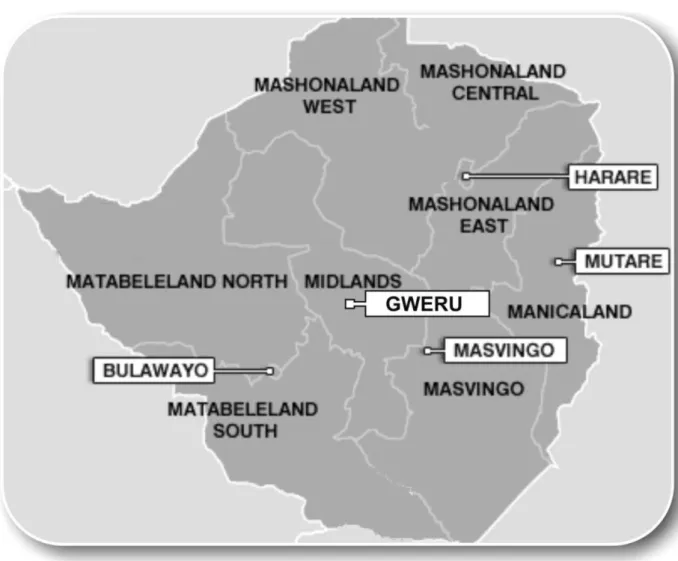
Research Design Implementation
The researcher was also faced with the question of the course of action to be taken in cases where the quantitative and qualitative results did not agree. After the analyzes of the two initial results, the researcher reached the point of connection and worked to merge the results of the two (2) data sets in Chapter 7: Discussion, Analysis and Interpretation: Mixed Method.
Research Design Implementation
- Geographic Location of Phase One Implementation
- Sample Type
- Structured Questionnaires i. Advantages of using Questionnaires
- Phase One - Data Collection and Survey Response Rate
- Data Analysis - Phase One
- Sampling for Focus Group Interviews
- Geographic Location of Phase Two Research Sites
- Sampling Strategy of Phase Two
To ensure a better response rate and reliability and validity of the data collected, the researcher. The use of two (2) interviewers meant that one (1) person facilitated the discussion (the moderator) and the other person took notes.
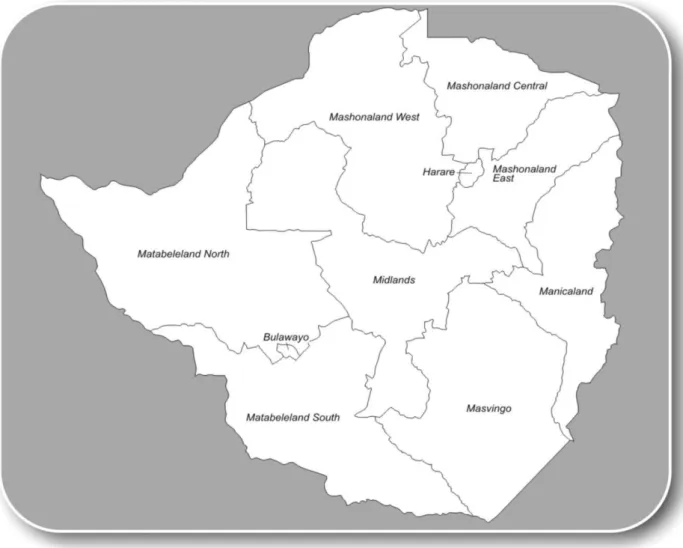
Phase Two Data Collection
- Semi-structured Questionnaire for Focus Group Interviews
- Pilot Study / Testing
- Focus Group Interviews: Data Collection
Participants included informal manufacturing SMEs in food processing, bakery and confectionery, toiletry making, textile and clothing making, leather and rubber production, engineering and metal production, wood and furniture making , and representatives of the Informal Business Association in Zimbabwe. Participants in the focus group interviews were selected on a stratum basis to ensure that all informal manufacturing SMEs were fairly represented, with each participant coming from food, bakery and confectionery processing, toiletry production, textile and clothing production, leather and rubber manufacturing, engineering and metal manufacturing, timber and furniture manufacturing, representatives of the Informal Business Association in Zimbabwe (IBAZ), National Informal and Sector Association (NISA), representatives of the Zimbabwe Chamber of Informal Economy Association (ZCIEA), representative of the Hawkers and Vendors Association of Zimbabwe (HAVAZ), allowing a maximum of ten (10) people per group in the city.
Phase Two Data Coding and Analysis
In this study, the data was coded manually, resulting in the creation of code families and code quotes. For the coding process and analysis, the researcher used a team-based analysis of the in-depth data, despite also considering using the computer software to aid in the analysis.
Reliability
- Instrument Reliability for the Research Study
- Validity
Interpreter or inter-observer reliability - useful for assessing the degree to which different observers provide a consistent assessment of the same phenomenon. Content validity is the extent to which the measurement device, in this case the measurement questions in the questionnaire, provides sufficient coverage of the research questions.
Research Procedure
- Research Protocol
To ensure the generalizability of the research findings, the research sampling design for this research has been logically developed and some other important details in the data collection methods have been meticulously followed. During focus group interviews, the interviewer had to listen and take some notes as and when appropriate, but the researcher had to maintain control of the data collection (Stake, 1995).
Ethical Considerations
The researcher had to gain the trust, confidence and respect of the research participants and be a real person interested in the problems of informal manufacturing SMEs. Non-disclosure of confidential information about research participants (respect for privacy) – coded names were used for focus group interviews.
Summary of Chapter
DATA PRESENTATION, ANALYSIS AND INTERPRETATION
QUANTITATIVE DATA
Introduction
- Survey
- Data Preparation
The study focused on six (6) major informal SME sub-sectors, namely food processing, bakery and confectionery, toiletries, textile and garment manufacturing, leather and rubber manufacturing, engineering and metal manufacturing, and wood and furniture manufacturing. A survey method was considered the best to conduct this study and self-administered structured questionnaires were used to collect data from the informal manufacturing SMEs in the five (5) towns in Zimbabwe.
Survey: Primary Data Presentation
The highest percentage distribution of informal manufacturing SMEs in the sample was from Harare (29%), and the lowest was from Bulawayo (10.1%). This is in line with the findings of RBZ (2014), which found that informal manufacturing SMEs are concentrated in major urban areas such as Harare, Bulawayo, Gweru, Mutare and Masvingo.
General SME and Biographical Information
- Gender of the Respondents
- Categories of the Age Group of Respondents
- Marital Status of Respondents
- Educational Level of the Respondents
- Categories of the Informal Manufacturing SMEs
- Number of Employees in the Informal SMEs
- Number of Years of Operation in the Informal SMEs
- Designation of the Respondents of Informal SMEs Represented
- Status of the Informal SMEs in Terms of Exporting
- Value of the Informal SMEs’ Annual Sales/Revenue
All sample respondents were asked a question to indicate the category of informal production in which their business operated. The rationale for this question was to ascertain the value of annual sales levels of informal manufacturing SMEs in Zimbabwe.
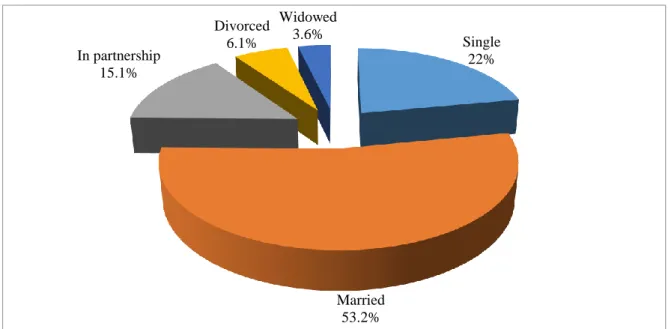
Running an Informal Manufacturing SME in Zimbabwe
- Access to Finance
- Infrastructure and Collateral Security
- Research, Development and Marketing Skills
- Business Structures, Environment and Location
- Entrepreneurial and Managerial Skills
- Legal and Regulatory Framework
We have strong research and development for our company in a similar study which concluded that most informal business owners lack the relevant skills to run their business, with the majority unable to keep proper accounts. The six (6) single measures: access to finance, infrastructure and collateral, research, development and marketing skills, business structures, environment and location, entrepreneurial and managerial skills, legal and regulatory framework were analyzed with the t-test to show relative “size ” of the challenges faced by the informal manufacturing SMEs.
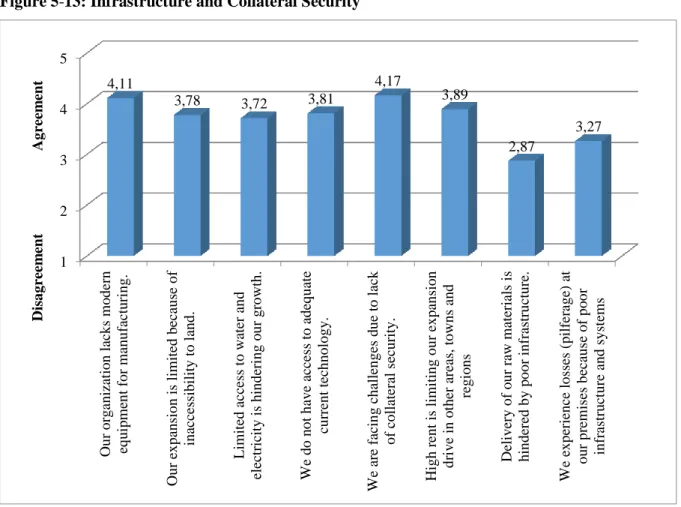
The mean scores for the constructs (M=mean) are > 3, indicating significant agreement among respondents that informal manufacturing SMEs contribute significantly to economic growth and development. The sample participants received seven (7) responses regarding the role of informal SMEs in job creation.
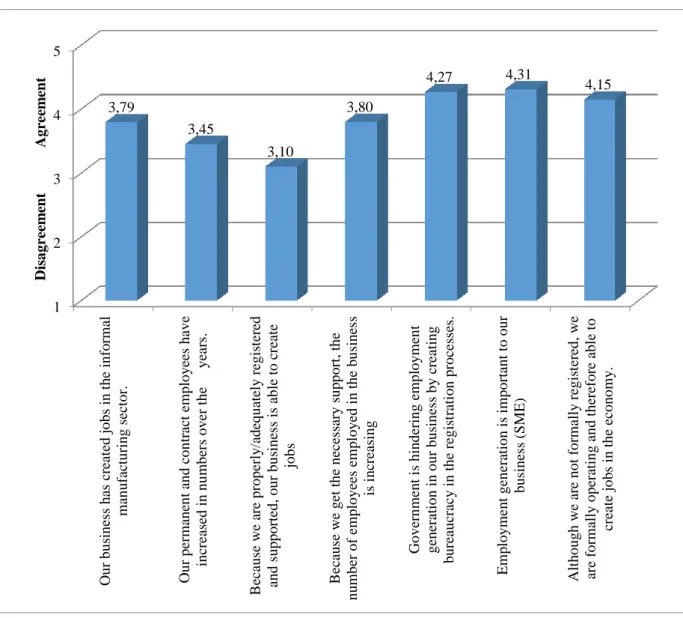
Effectiveness of Economic Programmes Aimed at Informal Manufacturing Enterprises in Zimbabwe
Government initiatives like start your business (SYB) and start and improve your business (SIYB) have helped our business. The single most reliable measure for this construct is all items (E1-E9) with an alpha of 0.779 which is higher than the minimum acceptable of 0.7.
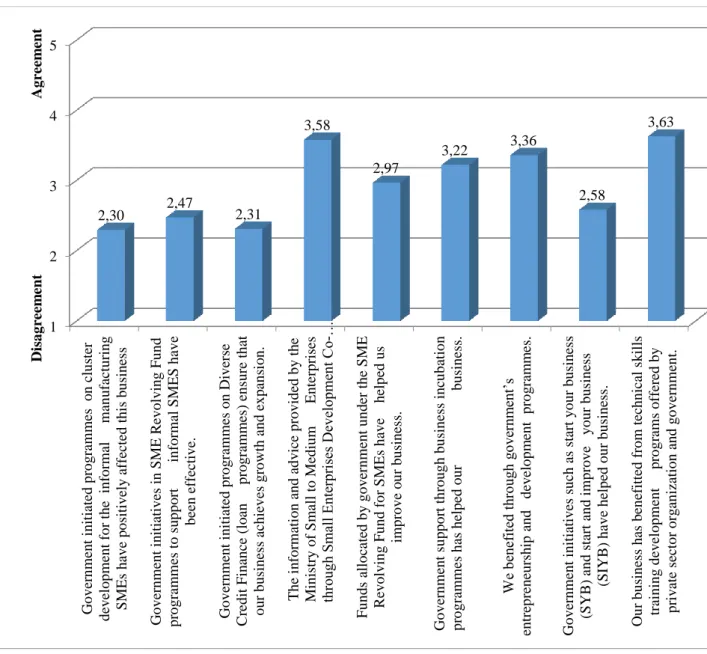
Mentorship Programmes in Zimbabwe
Small and Medium Business Development Chamber of India (SMBDCI) (2005), in line with the above sample findings, noted that SMEs do not receive the support relevant to their growth from the concerned ministries, banking institutions and companies, which hinders their growth . competitiveness in local and regional markets. The most reliable measure for this construct are items (F3-F5) (Appendix 9: Survey - Structured Questionnaire) with an alpha = 0.752, which is higher than the minimum acceptable of 0.7.
Summarised Analysis of the Four (4) Constructs .1 One-Sample Statistics and One Sample T-Tests .1 One-Sample Statistics and One Sample T-Tests
- Relationships between the Variables (Spearman’s Correlation)
5.9.2.1.
5.9.2.1(a) Infrastructure and Collateral Security (ICS) and Number of Employees The application of Spearman’s correlation indicated that there is an inverse relationship between
5.9.2.1(b) Infrastructure and Collateral Security and Years of Operating
Applying Spearman's correlation showed that there is a positive relationship between the number of employees and the challenge of business structures, environment and location. 5.9.2.3 (a) Entrepreneurial and managerial skills and the number of employees The application of Spearman's correlation showed that there is an inverse relationship between.
5.9.2.3 (a) Entrepreneurial and Management Skills and Number of Employees The application of Spearman’s correlation indicated that there is an inverse relationship between
A two-tailed test of significance indicated a significant correlation between the challenge of business structures, environment and location and employees, rho=0.089, p= 0.011. This challenge is seen as a greater challenge in informal manufacturing SMEs with a large number of employees.
5.9.2.3 (b) Entrepreneurial and Management Skills and Years of Operating
5.9.2.4 (a) Legal and Regulatory Framework and Number of Employees
5.9.2.4 (b) Legal and Regulatory Framework and Years of Operating
5.9.2.4 (c) Legal and Regulatory Framework and Value of Annual Revenue / Sales The application of Spearman’s correlation indicated that there is an inverse relationship between
5.9.2.5(b) Research, Development and Marketing Skills and Years of Operating The application of Spearman’s correlation indicated that there is an inverse relationship between
- Effectiveness of Mentorship Programmes and number of employees
- Access to finance
- Infrastructure and Collateral Security
- Business Structures, Environment and Location
- Entrepreneurial and Management Skills
- Legal and Regulatory Framework
- Research, Development and Marketing Skills
- Role of Informal Manufacturing SMEs on Economic Growth and Development in Zimbabwe
- Independent Sample T-Test: Exporter .1Access to finance
- Entrepreneurial and Management Skills
- Effectiveness of Economic Programmes Aimed at Informal Manufacturing Enterprises in Zimbabwe
- Mentorship Programmes in Zimbabwe
- Summary of Chapter
Informal manufacturing SMEs seem to play an important role in economic growth and development in the food, bakery and confectionery sector (M=3.9856) and in the leather and rubber sector (M=3.9699) compared to engineering/ foundry and metallurgy. (M=3.7794). Economic programs aimed at informal production enterprises were very effective in the toilet product manufacturing sector (M=3.2867), the food, bakery and confectionery processing sector.
QUALITATIVE DATA
Introduction
This chapter presents the results of the focus group interviews that were held in the country's five (5) major cities Harare, Bulawayo, Gweru, Masvingo and Mutare and the discussion of the research findings thereof. The discussion of the results presented in this chapter was made regarding the research objectives presented in the introduction in chapter 1, Literature review in chapter 2 and theoretical and conceptual framework in informality, chapter 3.
Focus Group Interviews: Primary Data Presentation
The highest percentage of participants in the focus group interviews was from Harare and Bulawayo 22.7% and the lowest was from Gweru, Masvingo and Mutare at 18.2% for all. The percentage of participants reflects the larger population in the two largest cities of Harare and Bulawayo.
General SME and Biographical Information
- Gender of the Respondents in the Focus Group Interviews
- Age Groups of Participants
- Marital Status of Participants
- Educational Level of Participants
- Categories of the Informal Manufacturing SMEs
- Number of Employees in the Informal Manufacturing SMEs
- Number of Years of Operation in the Informal SMEs
- Status of the Informal SMEs in Terms of Exporting
Respondents participating in focus group interviews were required to indicate their marital status. The participants involved in the focus group interviews were asked a question about the level of their highest educational qualification.
